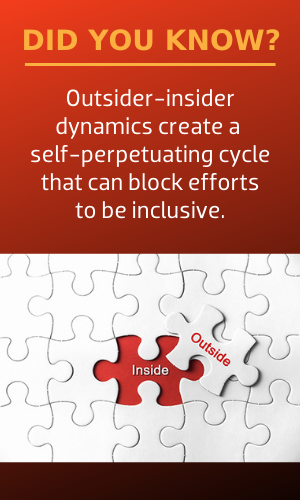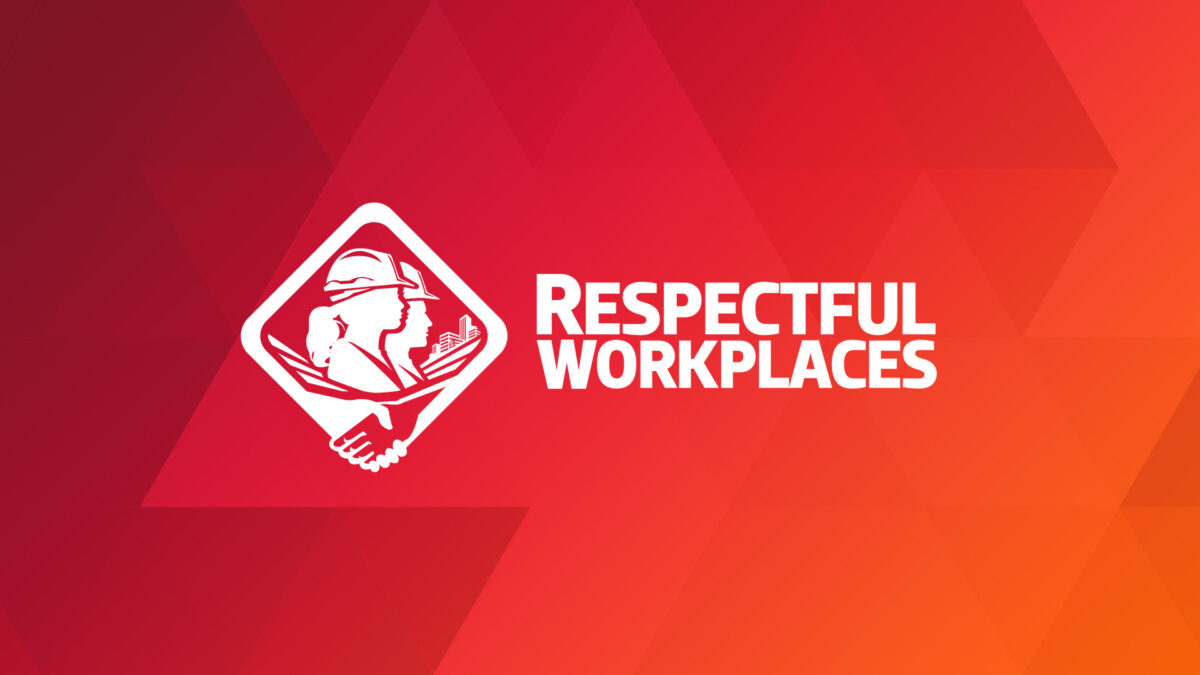Does your organization understand the impact of outsider-insider dynamics on its efforts to be inclusive?

Readers will remember that “outsider” and “insider” groups are present in all organizations. (See Blog #50). They are different than groups based on the business priorities of an organization, such as departments and teams. Instead, outsider and insider groups are based on one or a combination of personal characteristics, or social group identities, such as age, ethnicity, gender, race, or on education level, where you grew up, what your first language is, and so on.
Those individuals with characteristics that differ from the most powerful people in an organization will likely experience patterns of obstacles to success. Outsider-insider groups create dynamics based on power: the insider group is the group with more power, while the outsider group has less power.
Addressing these dynamics can help organizations to reduce systemic racism. This will help to change the patterns of experience that can limit the career opportunities and success of Black, Indigenous, and People of Colour.
However, there are…
Four key characteristics of outsider-insider group dynamics that create a self-perpetuating cycle that can block efforts to be inclusive of Black, Indigenous, and People of Colour
1. Level of awareness
Outsiders are more likely to be aware of their social group membership than insiders because barriers often emerge based on their social group identity. They also have more information about the obstacles in an organization because of their lived experience.
In contrast, insiders tend not to be aware of their group membership because they never experience obstacles based on their social group identity. They also have less information about the obstacles for outsiders, or if they are aware, they may believe the obstacles are not as prevalent as they may actually be.
2. Different patterns of experience
Group membership produces a fundamentally different pattern of experience. Research shows that Black professionals are more likely to experience patterns of obstacles based on their race than white professionals. In contrast, insiders are likely to experience patterns that help them to succeed.
This results in a differing perception of the significance of the obstacles. When insiders are made aware of barriers or injustices, they may view them as isolated events. As a result, there is no sense of urgency for insiders to take action. However, because of the prevalence of the barriers in their lives, outsiders are more likely to view obstacles or injustices as significant.
3. Willingness to engage
Members of outsider and insider groups are often unwilling to engage about their group membership, but for different reasons. Insiders may not see the need to talk about the impact of something they are not even aware of. This also relates to the notion that we are taught in North America (and elsewhere) to see ourselves as individuals in control of our destiny, and not as members of a group.
For outsiders, there may be a reluctance to acknowledge and focus on barriers that they feel they have little control over. To talk about the personal experience of racism can be upsetting and demoralizing. They also report that often they get negative and defensive reactions when they talk about the obstacles they experience.
4. Setting norms and adapting to norms
Being an outsider generally means having to understand and adjust to the insider group’s ways of thinking and doing, how to compete, how to distinguish yourself, how to engage others, and how to disagree or agree. Outsiders who succeed often report that they must leave their true selves at home in order to succeed.
These dynamics come together to create a self-perpetuating cycle that can block an organization’s best intentions to be inclusive of Black, Indigenous, and People of Colour.
To the extent that outsiders feel reluctant to share their true experiences, the less informed insider perspective remains dominant. As a result, the insider perception that a person’s race isn’t a factor is reinforced. The perspective doesn’t change; behaviour doesn’t shift, and outsider-insider dynamics continue. And because some outsiders succeed in adapting, insiders may believe that this is proof that any individual can be successful, and the status quo remains.
The cost to an organization is frustration, discouragement, and loss of motivation among members of outsider groups, not to mention the cost of losing talented individuals. Understanding the impact of outsider-insider group dynamics helps leaders and managers identify where obstacles to inclusion exist, how they are being unintentionally reinforced, and develop effective strategies to shift the status quo.
—
The BuildForce Respectful Workplace Online Toolkit provides three tools based on the proven practices of respectful and inclusive organizations to help address systemic racism: the Online Self-Assessment Tool, a Policy Framework and Implementation Guide, and the online course, “Working in a Respectful and Inclusive Workplace.”
The management Self-Assessment Tool provides a blueprint of the actions required to identify and re-work systems where unconscious bias may be impacting management goals to be fair and inclusive in their recruitment, promotion, and retention practices.
Also look for the new BuildForce online course, to be released in early 2021, to help leaders and managers to understand systemic racism. BuildForce is also developing a new module for the “Working in a Respectful and Inclusive Workplace” course to help workers develop awareness about systemic racism, also to be released in 2021.
For more info:
- CoQual. “Being Black in Corporate America: An Intersectional Exploration.” 2019. See
https://coqual.org/wp-content/uploads/2020/09/CoqualBeingBlackinCorporateAmerica090720-1.pdf. - Deloitte. “The Diversity and Inclusion Revolution: Eight Powerful Truths.” January 2018. See: www2.deloitte.com/us/en/insights/deloitte-review/issue-22/diversity-and-inclusion-at-work-eight-powerful-truths.html.
- Donovan, Mason and Mark Kaplan. “The Inclusion Dividend, 2nd Ed.” DG Press, New Hampshire, U.S., 2019.
Read from the beginning. Click here to start at Part 1.
What can an effective Respectful and Inclusive Workplace Program deliver?
- Become an employer of choice – attract, retain, and advance top talent from all sources of labour
- Unlock collaboration and innovation – create high-performing teams through diversity of thought and experience
- Build your brand – your organization will gain a competitive edge as a leader and innovator
Get started today!
The BuildForce Canada Online Respectful and Inclusive Workplace Toolkit includes:
- the Respectful Workplace Online Self-Assessment Tool to assist organization leadership in assessing their current situation and identifying where they may need to make changes
- the Respectful Workplace Policy Framework and Implementation Guide to assist organizations in creating and implementing a policy that supports a respectful and inclusive workplace
- the Respectful Workplace Online Training Course to train workers on how to create and support a respectful and inclusive workplace
- the online course Introduction to Understanding Systemic Racism: A Guide for Leaders and Managers
All the resources you need to create and support a respectful and inclusive workplace!

Respectful and Inclusive Workplaces
